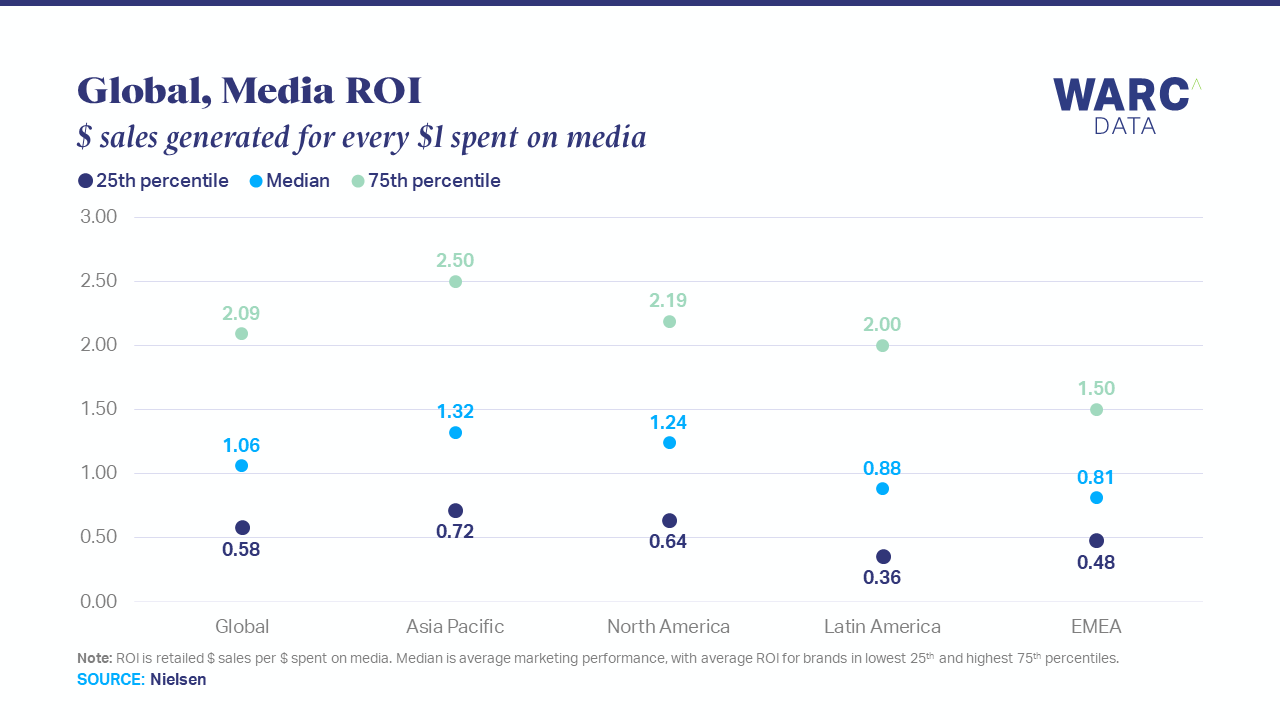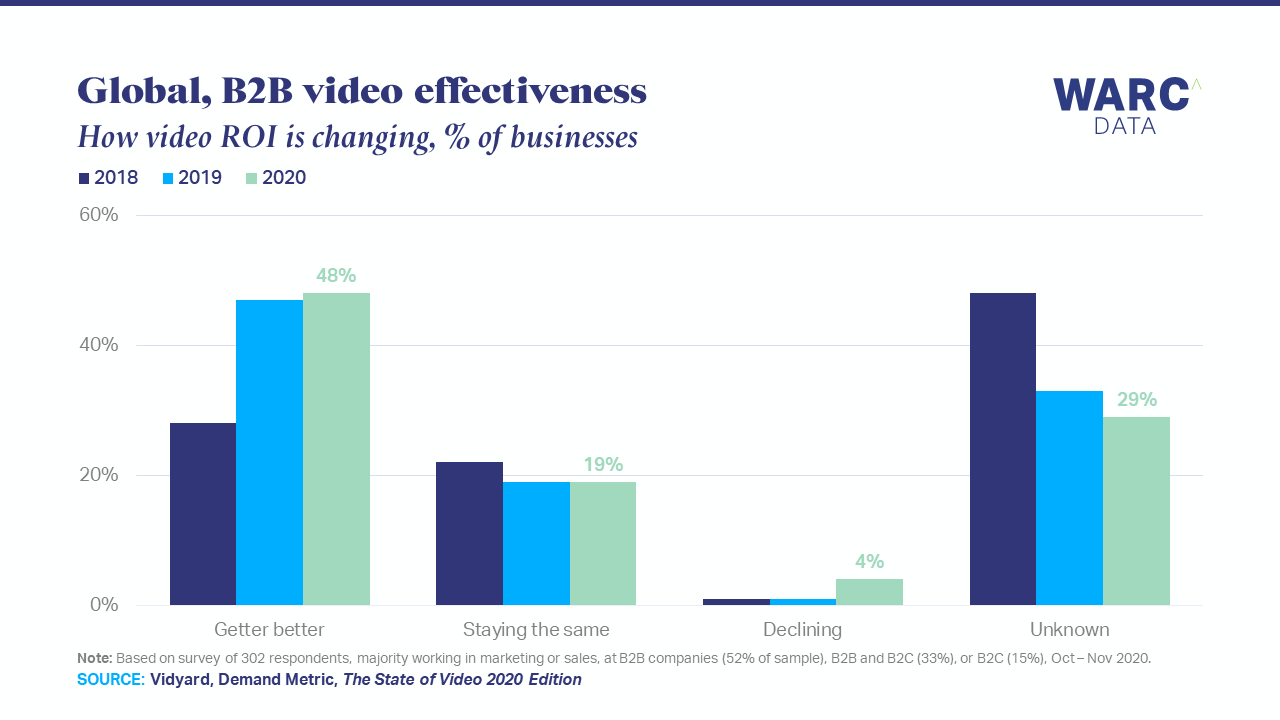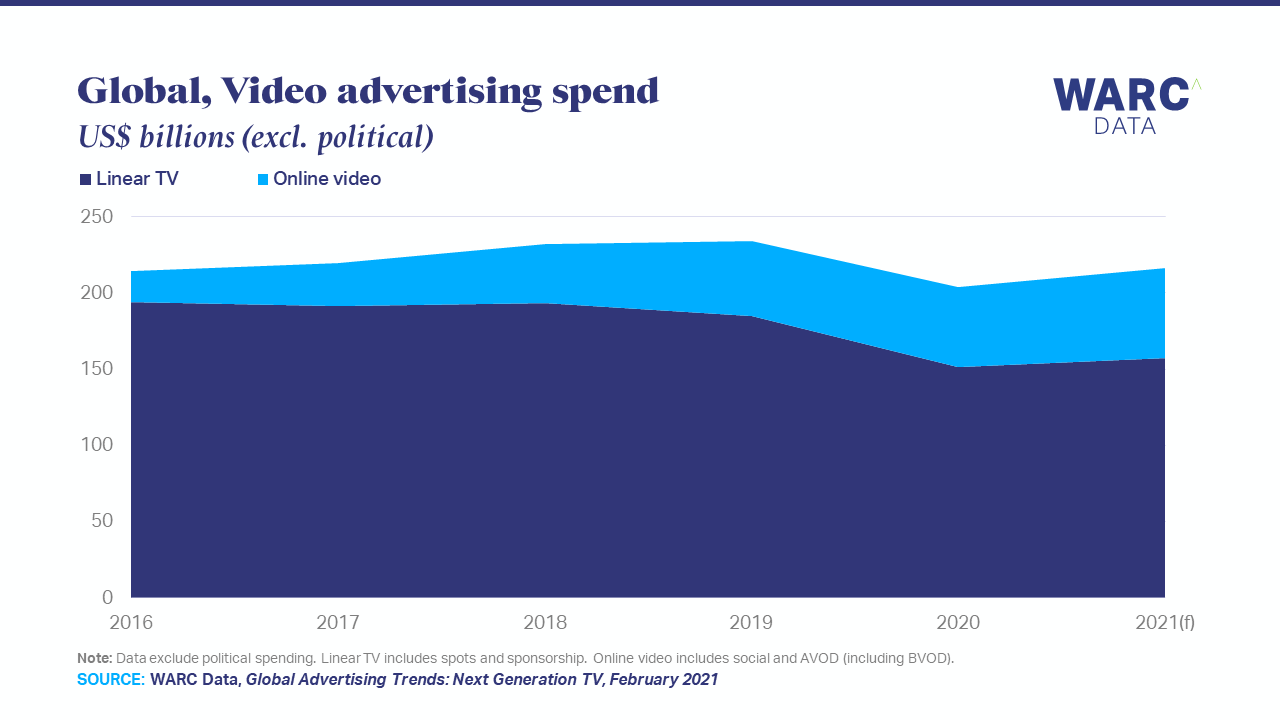Half of brands achieve an ROI of $1.06, but the most effective can double this
For every $1 spent on media, advertisers can expect an average sales return of $1.06, according to data from Nielsen. The most effective 25% of advertisers, however, can achieve a return on investment (ROI) of $2.09 – nearly double the average.
This can rise further still – the median ROI in WARC’s analysis of the most successful brands is $3.99.

Nielsen notes that there can be regional variation, though. Advertisers in Europe, the Middle East, and Africa (EMEA) see the smallest range of ROI between the 25th and 75th percentiles, suggesting some level of consistency in performance. In Latin America, however, the top 25% of advertisers achieve an ROI 450% larger than the bottom 25%.
The methods for achieving higher levels of return can also differ significantly between advertisers.
Among short-term factors, which advertisers have the greatest control over, reach and ad quality are the most important drivers of ROI.
For marketers in the food category, though, ad quality is of far lower significance while frequency proves to be of above-average importance. For those in the hygiene and health category, duration and daypart rank higher than ad quality.
Marketers also need to recognise the importance of long-term factors. Structural factors, like brand size and brand dollar, drive over half (57%) of advertising’s ROI. This is particularly true for automotive brands as this figure rises to 62%.
Again, the differences across categories are notable. Short-term creative is particularly influential for the tech, comms and retail categories, where it drives one-fifth (20%) of ROI.
While the specifics for each category may vary, research from WARC and Cannes Lions has uncovered some key recommendations for practitioners. A combination of informed budgets, insightful strategy and creative output can deliver greater levels of effectiveness.
The WARC Awards for Effectiveness is a new global competition showing how marketing delivers business results. Entries close on April 1st and all those shortlisted will receive feedback on how they have performed on the Creative Effectiveness Ladder.
Challenges with ROI but new opportunities emerge for B2B marketers
The effectiveness of video content is improving for B2B businesses, but accurate measurement is often found wanting and ROI remains a challenge. This is according to a survey of marketers and sales people in mostly B2B or B2B/B2C companies from Vidyard and Demand Metric.
Half of those surveyed said their video ROI is getting better (48%), a similar level to 2019. As well as this, the share of B2B companies saying their ROI is unknown has dropped from 48% in 2018 to under one-third (29%) in 2020.

However, the research also finds that measuring ROI remains the most common challenge for B2B businesses when trying to effectively use video.
Progress has so far been limited – just 7% of those surveyed say their measurement is ‘advanced’, considering metrics like viewer drop-off rates and sales attribution. Instead, ‘basic’ metrics like the number of views prove most common.
This lack of a clear ROI is a common concern – additional research shows three quarters of TV ads deliver no long-term growth for B2B brands. This can come from an over-reliance on short-term activation and a lack of clear brand building.
WARC’s research into B2B marketing, including a survey of more than 330 practitioners in the tech and telco sectors, reveals some interesting trends that may help boost effectiveness.
The disruption of the coronavirus outbreak means this is a time of learning and discovery for B2B marketers. For example, half of those surveyed said they are experimenting with channels they have never tried before. This has prompted brands to use a broader multimedia mix that includes newer channels like audio and streaming.
Although more channels may introduce more complexity, B2B marketers are pushing for a clear focus. Four fifths of those surveyed say they need to be more focused on building strong brands.
This aims to provide a secure base from which B2B content can work harder and more effectively. For tech and telco B2B brands, there is a new significance on storytelling and in finding relevant partners to help deliver those stories in compelling ways.
WARC surveyed more than 330 B2B marketers in 10 markets across the world who operate within the tech and telco sectors. Changing Channels in B2B includes a deep-dive into each of the four themes, CMO views, data analysis, and key takeaways. Download the full report here.
Next gen TV attracts audiences and advertisers
Linear TV advertising spend has fallen by $47bn over the last five years as online channels attract audiences and investment, according to WARC Data’s latest research.
Over the same period, online video investment has grown $38.7bn and more than doubled in size. This includes advertiser-funded video-on-demand (AVOD), broadcaster video-on-demand (BVOD) and short-form social formats.

While linear TV remains 2.5 times larger, this gap will narrow as advertisers follow audiences.
WARC Data estimates that two fifths of online consumers worldwide now have an internet-connected TV, a new high and a trend that is likely to continue.
There are clear regional differences for streaming, though. Mobile devices prove more popular in Asia, while over half of audiences in India (57%) and China (45%) say they watch live TV content on their mobile, tablet or PC.
However, many advertisers say they are struggling to leverage connected TV advertising effectively. Less than a quarter of digital video decision makers believe they are optimal in core areas such as reaching the right audience, delivering effective creative and selecting appropriate media types.
Success may instead be found in integrating the management of all forms of TV media, allowing advertisers to achieve better measurement and greater effectiveness across their investments.
WARC Data's latest report analyses how video viewing has evolved and how brands are reacting to the next generation of TV. It also includes an analysis of TV spots during the coronavirus outbreak, drawing from over 15m measured ads.
WARC Data subscribers can access the full report here. A free sample report is available to non-subscribers here.
Source: Warc.com

